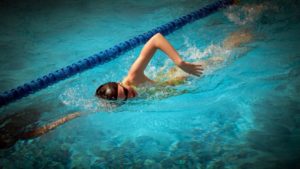Catch up drill & correcting a cross over

Drills are a fundamental part of swim training. Because water is so thick, we have to constantly work on our form and technique to ensure we are travelling as efficiently as we can. Drills can be incorporated alongside full stroke as part of steady aerobic sets, as parts of warm ups and cool downs or even as part of a recovery from harder swims. They make you stay on point with your stroke (provided you’re focusing on making those habits stick!), there is NO reason not to do them!
One of the most common issues within athletes’ strokes that I see is a cross over pull – i.e. hands coming across under the body and causing the body to snake around. This tends to happen for one of 3 reasons:
- Core not being engaged – this either means that the hips will be low or that the shoulders are doing all the work. Either way, you lose a lot of control and as a result, power!
- Hands swinging around the sides – as we have mentioned before, a straight arm recovery isn’t a problem. But if your arms come out and round the sides rather than up and over, then where you put your hands in becomes much more variable or out of control.
- Extending from the shoulder and allowing the hand to cross over the centre line – if you can keep a straight line between your hip, shoulder and hand, things will stay a lot more controlled, minimising lateral movement.
Catch up is a great drill to sort out all of these problems. By always having a hand out in front of your head it helps engage your core and keeping your posture super strong. Because you have to focus on good rotation (otherwise its difficult to get your hands out of the water) your arms will recover higher and enter more in line. And because you have the opposite hand in front you can’t cross over the centre line on entry.
Why Do It:
Doing the catch-up drill has many different benefits to it:
1) Improves the length of the stroke.
2) Helps maintain posture and core rigidity.
3) Focus on engaging pressure on the water on your hands and forearms right at the very front of your stroke.
4) Making sure that you’re pull is symmetrical, balanced.
How To Do It:
1. Start with a standard streamline push off, and keep your thumbs together.
2. Take a stroke with your right arm, keeping your left arm out in front of you.
3. As your right hand recovers stretch it forward to meet your left hand out in front.
4. Repeat with the left hand, and continue.

How To Do It Really Well:
If you swim the catch up drill slowly, you can think through each of the focus points of the drill. By making sure you meet thumb to thumb at the front end, you can get the maximum out of your stroke length. This doesn’t mean that when you swim you have to have a glide (though for some that works!), but you’ll be able to travel a bit further per stroke, and gain better leverage. Also by having both arms stretched out in front, you pull your core and glutes in tight, which will minimise drag and help your body flow through the water better. As you pull each time, you can focus on really feeling the pressure of the water on your hands and forearms; as we have discussed before, this is what will help you move forwards. And finally, if you keep your head still then you can watch your hands come through under your nose, and replicate the same action on both sides. If you really want to make sure you keep your head still, you can always invest in a front mounted snorkel. This isn’t a complete necessity though!
Cross Over the Centerline/Wide Entry
Swim a length where you deliberately let your hands cross the centerline. Did you wiggle? Did you notice a loss of power…or that crossing over took more effort? Now swim a length where you enter the hands wide – outside the shoulders. What do you notice?
If you have trouble entering wide, swim half a length of “water polo” freestyle, with your head out of the water. You can see exactly where your hands are entering and can keep the entry outside the shoulders.
After half a length with your head out, put your head in and keep swimming, but with the hands entering just outside the shoulders. Notice how the wider entry sets you up for a high-elbow catch and helps you put the power at the front part of your stroke.
Take your time with this – as with any drill. The point is that drills are there to make you smoother, stronger, more efficient. Make sure you hit all those target points!
If you have any questions or comments, please feel free to get in touch; either by email, facebook or leave a comment on here!
See what’s up next week for our #SwimTechTues tip!
